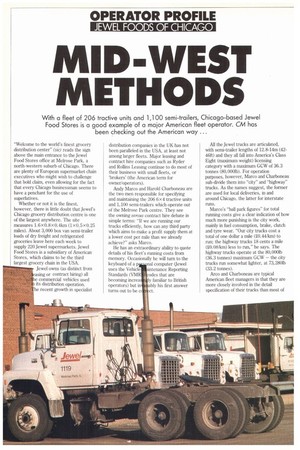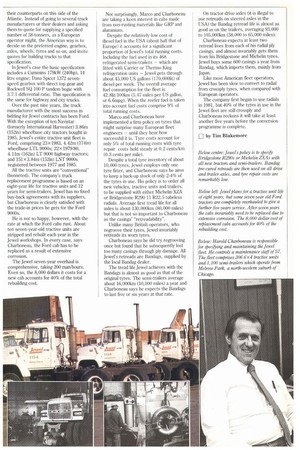MID WEST
Page 38

Page 39

If you've noticed an error in this article please click here to report it so we can fix it.
METHODS
"Welcome to the world's finest grocery distribution center" (sic) reads the sign above the main entrance to the Jewel Food Stores office at Melrose Park, a north-western suburb of Chicago. There are plenty of European supermarket chain executives who might wish to challenge that bold claim, even allowing for the fact that every Chicago businessman seems to have a penchant for the use of superlatives.
Whether or not it is the finest, however, there is little doubt that Jewel's Chicago grocery distribution centre is one of the largest anywhere. The site measures 1. 6 x 0. 8 x 0.41on (1 x 0.5 x 0.25 miles). About 3,000 box van semi-trailer loads of dry freight and refrigerated groceries leave here each week to supply 220 Jewel supermarkets. Jewel Food Stores is a subsidiary of American Stores, which claims to be the third largest grocery chain in the USA.
Jewel owns (as distinct from asing or contract hiring) all e commercial vehicles used its distribution operation. he recent growth in specialist distribution companies in the UK has not been paralleled in the USA, at least not among larger fleets. Major leasing and contract hire companies such as Ryder and Rollins Leasing continue to do most of their business with small fleets, or 'brokers' (the American term for owner/operators).
Andy Marco and Harold Charboneau are the two men responsible for specifying and maintaining the 206 6 x4 tractive units and 1,100 semi-trailers which operate out of the Melrose Park centre. They see the owning versus contract hire debate in simple terms: "If we are running our trucks efficiently, how can any third party which aims to make a profit supply them at a lower cost per mile than we already achieve?" asks Marco.
He has an extraordinary ability to quote details of his fleet's running costs from memory. Occasionally he will turn to the keyboard of a p' •nal computer (Jewel
uses the Vehicle intenance Reporting Standards (VMR odes that are becoming increa ly familiar to British operators) but in ably his first answer turns out to be c ct.
All the Jewel trucks are articulated, with semi-trailer lengths of 12.8-14m (4246ft) and they all fall into America's Class Eight (maximum weight) licensing category with a maximum GCW of 36.3 tonnes (80,0001b). For operation purposes, however, Marco and Charboneau sub-divide them into "city" and "highway" trucks. As the names suggest, the former are used for local deliveries, in and around Chicago, the latter for interstate runs.
Marco's "ball park figures" for total running costs give a clear indication of how much more punishing is the city work, mainly in fuel consumption, brake, clutch and tyre wear. Our city trucks cost a total of one dollar a mile (£0.44/km) to run: the highway trucks 18 cents a mile (E0.08/km) less to run," he says. The highway trucks operate at the 80, 0001b (36.3 tonnes) maximum GCW — the city trucks run somewhat fighter, at 73,280lb (33.2 tonnes).
Arco and Charboneau are typical American fleet managers in that they are more closely involved in the detail specification of their trucks than most of their counterparts on this side of the Atlantic. Instead of going to several truck manufacturers or their dealers and asking them to quote for supplying a specified number of 38-tonners, as a European operator might, the American way is to decide on the preferred engine, gearbox, axles, wheels, tyres and so on, and invite quotes for building trucks to that specification.
In Jewel's case the basic specification includes a Cummins 179kW (240hp), 14 litre engine: Dana Spicer 1372 sevenspeed gearbox with direct top gear and Rockwell SQ 100 P tandem bogie with 3.7:1 differential ratio. This specification is the same for highway and city trucks.
Over the past nine years, the truck manufacturer with the most success in bidding for Jewel contracts has been Ford. With the exception of ten Navistar (formerly International Harvester) 3.86m (152in) wheelbase city tractors bought in 1985, Jewel's entire tractive unit fleet is Ford, comprising 23x 1983, 4.42m (174in) wheelbase LTL 9000s; 22 x1979/80, 4.11m (162in) LT 9000 highway tractors; and 151 x 3.84m (152in) LNT 9000s registered between 1977 and 1985.
Al the tractive units are "conventional" (bonneted). The company's truck replacement programme is based on an eight-year life for tractive units and 12 years for semi-trailers. Jewel has no fixed buy-back agreements with its suppliers, but Charboneau is clearly satisfied with the trade-in prices he gets for the Ford 9000s.
He is not so happy, however, with the rate at which the Ford cabs rust. About ten seven-year-old tractive units are stripped and rebuilt each year in the Jewel workshops. In every case, says Charboneau, the Ford cab has to be replaced as a result of extensive corrosion.
The Jewel seven-year overhaul is comprehensive, taking 200 man/hours. Even so, the 8,000 dollars it costs for a new cab accounts for 40% of the total rebuilding cost. Not surprisingly, Marco and Charboneau are taking a keen interest in cabs made from non-rusting materials like GRP and aluminium.
Despite the relatively low cost of diesel fuel in the USA (about half that of Europe) it accounts for a significant proportion of Jewel's total running costs. Including the fuel used in its 468 refrigerated semi-trailers — which are fitted with Carrier or Thermo King refrigeration units — Jewel gets through about 45,000 US gallons (170,000lit) of diesel per week. The overall average fuel consumption for the fleet is 42.81it/100km (5.47 miles per US gallon, or 6.6mpg). When the reefer fuel is taken into account fuel costs comprise 9% of total running costs.
Marco and Charboneau have implemented a firm policy on tyres that might surprise many European fleet engineers — until they hear how successful it is. 'l'yre costs account for only 5% of total running costs with tyre repair costs held steady at 0.2 cents/km (0.3 cents per mile).
Despite a total tyre inventory of about 10,000 tyres, Jewel employs only one tyre fitter, and Charboneau says he aims to keep a back-up stock of only 2-4% of the tyres in use. His policy is to order all new vehicles, tractive units and trailers, to be supplied with either Michelin XZA or Bridgestone R290 11 R22.5 tubeless radials. Average first tread life for all axles is about 130,000km (80,000 miles) but that is not so important to Charboneau as the casings' "retreadability".
Unlike many British operators, who regroove their tyres, Jewel invariably retreads its worn tyres.
Charboneau says he did try regooving once but found that he subsequently lost too many casings through ply damage. All Jewel's retreads are Bandags, supplied by the local Bandag dealer.
The tread life Jewel achieves with the Bandags is almost as good as that of the original tyres. The semi-trailers average about 16,000km (10,000 miles) a year and Charboneau says he expects the Bandags to last five or six years at that rate. On tractor drive axles (it is illegal to use retreads on steered axles in the USA) the Bandag retread life is almost as good as on the trailers, averaging 93,000 to 105,000km (58,000 to 65,000 miles).
Charboneau expects at least two retread lives from each of his radial ply casings, and almost invariably gets them from his Bridgestone and Michelin tyres. Jewel buys some 600 casings a year from Bandag, which imports them, mainly from Japan.
Like most American fleet operators, Jewel has been slow to convert to radial from crossply tyres, when compared with European operators.
The company first began to use radials in 1981, but 40% of the tyres in use in the Jewel fleet are still crossply and Charboneau reckons it will take at least another five years before the conversion programme is complete.
























































































































